SEED Grants 2017
A Deep Learning Approach to Mitigate Reconstruction Artifacts in Low-Dose Transmission Electron Tomography
| Matthew Dawber SBU, Physics and Astronomy Andrei Fluerasu BNL, NSLS II |
 Matthew Dawber |
 Andrei Fluerasu |
Towards a Quantum Network Connecting SBU and BNL
| Eden Figueroa-Barragan SBU, Physics and Astronomy Andrei Nomerotski BNL, Cosmology and Astrophysics |
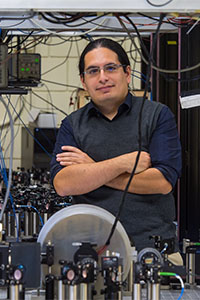 Eden Figueroa-Barragan |
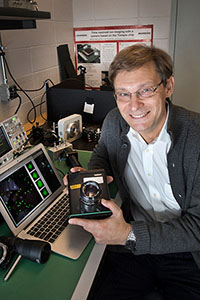 Andrei Nomerotski |
Public interest in quantum technology is fueled by the visions of quantum computers and global quantum communication networks. The shift to having low-cost, miniaturized room temperature quantum devices will make such realizations practical and economically feasible. This will not only decisively change secure world-wide information transfer, but it will also provide a robust technological platform to implement fundamental quantum computation algorithms. We propose an ambitious research project aimed at bringing together the advanced fast imaging of single photons at BNL with state of the art quantum light-matter interfaces at SBU to investigate how the combination of these powerful tools could deliver a first prototype of a quantum network in which quantum information can be communicated over long distances.
Our collaboration will bring together a unique combination of expertise and equipment to enable to perform first-ever experiments in quantum communication with several quantum memories in a quantum network configuration. We will pioneer the use of a single-photon-sensitive camera to improve the performance of single photon sources, characterize the output of light-matter interfaces and efficiently monitor the process of entanglement swapping, thereby achieving maximum enhancement in performance for the quantum network operation.
Theory-Enabled Reconstruction of 3D Structure of Single Atom Catalysts
| Anatoly Frenkel SBU, Material Science Deyu Lu BNL, Center for Functional Nanomaterials |
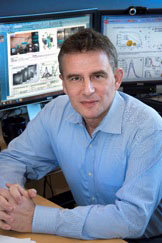 Anatoly Frenkel |
 Deyu Lu |
Single atom catalysts (SACs) are attracting increasing attention due to their enhanced activity and stability Their rational design is impeded by the paucity of experimental techniques to obtain activity descriptors that can be controlled by synthesis and assessed by theory and in situ characterization methods. Our team will tackle this challenge by exploiting remarkable sensitivity of X-ray absorption spectra of catalytically active ions to the geometry of their local environments. We propose to simulate their spectra by predicting reaction pathways with first principle theories, and then creating theoretical X-ray spectra that can be directly compared with experimental ones. Our work will benefit catalysis researchers that will utilize both NSLS-II and CFN facilities for doing theory-enabled analysis of catalytic geometries. Due to the central role that the X-ray absorption near-edge structure (XANES) region of XAS plays in the proposed method, this work will also stimulate research and development in the field of in situ and operando catalysis studies by high energy resolution spectroscopy at the NSLS-II beamline ISS.
Development of Radiolabeled Drugs to Study Novel Gastric Cancer Models
| Joseph Kim SBU, Department of Surgery Cathy Cutler BNL, Collider-Accelerator Department |
 Joseph Kim |
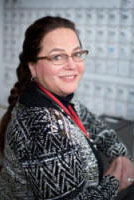 Cathy Cutler |
Gastric cancer is a devastating condition with mostly poor survival for the nearly 1 million patients afflicted yearly with this disease. Major advances in personalized therapies including monoclonal antibodies (mAb) have improved survival for many cancers, but the benefits remain marginal for gastric cancer. One gap in treatment is that effective mAbs for gastric cancer may already exist in clinical practice, but have yet to be tested in gastric cancer. The second gap in treatment is that the efficacy of a gastric cancer therapy may be unique only to select patients. Accordingly, we propose to establish an accurate and expeditious diagnostic platform that provides data to make actionable clinical decisions on mAbs for gastric cancer. To this end, we propose to build upon our prior work and develop gastric cancer organoids for gastric cancer patients and use radiolabeled antibodies to select optimal therapeutic drugs. This proposal capitalizes on the clinical and translational science expertise of Stony Brook Medicine and Brookhaven National Laboratory.
Large-Scale Comparative Regulatory Network Analysis in Photosynthetic Organisms
| Daifeng Wang SBU, Biomedical Informatics Ian Blaby BNL, Biology Department |
 Daifeng Wang |
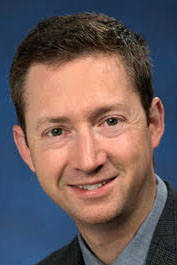 Ian Blaby |
As primary bioproducers, photosynthetic organisms are fundamental to biological and geochemical cycles. Yet, despite recent availability of genome-wide engineering tools, biological redesign to exploit plants for increased biomass, bioenergy and food production purposes is fundamentally thwarted by a lack of foundational knowledge in plant gene regulation and protein function. This project will explore novel computational and network science approaches to comparatively analyze plant transcriptomes. This will enable elucidation of gene regulatory networks, genetic circuits, regulatory components and facilitate gene functional inferences. We will develop and apply our approaches on complex genomes to identify functionally related gene co-expression modules, infer gene regulatory networks and elucidate gene regulatory circuits driving evolutionarily conserved and species-specific genomic functions. Specifically, we propose to apply large-scale comparative analyses based on network science and machine learning approaches to study gene networks across multiple photosynthetic organisms and simultaneously cluster these networks into functional gene modules. Species-specific and cross-species modules will be exploited to infer gene function where presently none exist. We will initially focus on the Department of Energy (DOE) Office of Biological and Environmental Research (BER) flagship organisms (taxonomically diverse photosynthetic species of high relevance to DOE missions), although additional organisms can be added to the study during the course of the project. However the proposed comparative analysis will benefit all of the plant genomics community, and by virtue of gene evolutionary conservation, biology at large. While our research will initially be focused on transcriptomic data, the computational genomics platform we will develop will be able to integrate and analyze multi-omics data such as metabolomics, proteomics and protein-protein interactions.
